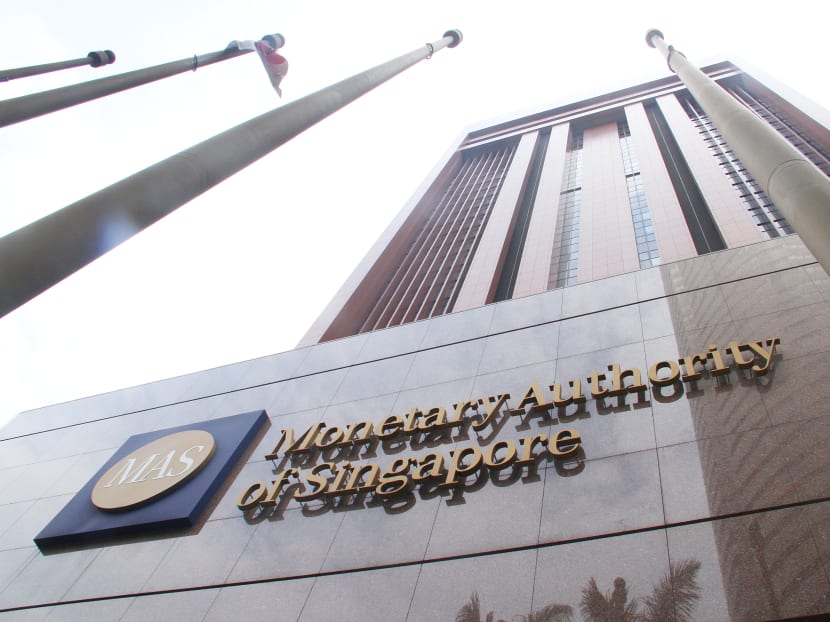MAS makes slight adjustment to slope of monetary policy band
SINGAPORE — For the second time this year, the Monetary Authority of Singapore (MAS) eased monetary policy by allowing the Singapore dollar to appreciate at a “slightly” slower pace against those of its trading partners — a milder-than-expected move that sent the local currency appreciating versus the greenback.

MAS narrowed its all-items and core inflation forecast to -0.5 per cent and 0.5 per cent, respectively. Photo: Daryl Kang
SINGAPORE — For the second time this year, the Monetary Authority of Singapore (MAS) eased monetary policy by allowing the Singapore dollar to appreciate at a “slightly” slower pace against those of its trading partners — a milder-than-expected move that sent the local currency appreciating versus the greenback.
The central bank, in its scheduled monetary policy statement today (Oct 14), said it will continue with the stance of a modest and gradual appreciation of the Singapore dollar nominal effective exchange rate (SGD NEER) policy band. Besides the “slight” adjustment of the slope, there will be no change to the width of the policy band and the level at which it is centred, it said.
The move comes after the central bank, which uses the currency rather than interest rates as its main policy tool, surprised markets in January by reducing the slope of the policy band in an unscheduled announcement, but maintained all other parameters. It held off from easing monetary policy again at its regular scheduled meeting in April.
“This measured adjustment follows the move to reduce the rate of appreciation of the policy band in January this year, and is supportive of economic growth into 2016, while ensuring price stability over the medium term,” it said.
It added that growth was “slightly weaker than earlier envisaged”.
MAS also narrowed its all-items and core inflation forecast to -0.5 per cent and 0.5 per cent, respectively. These are the lower end of its earlier projections of between -0.5 and 0.5 per cent for all-items inflation and 0.5-1.5 per cent for core inflation.
The central bank’s easing today was seen as disappointing to some market watchers, who were expecting more aggressive action, such as a larger adjustment of the slope, re-centering the mid-point of the policy band or widening the band.
Fifteen out of 25 analysts polled by Reuters had expected the central bank to ease, while 16 out of 25 of those surveyed by Bloomberg predicted the same.
“Coupled with the stronger-than-expected advance estimate of third-quarter growth, the MAS appears to be more relaxed over the growth path than the market believes… We believe the smaller-than-expected slope adjustment was a token signal, as there was no material change to the authority’s assessment of growth and CPI (Consumer Price Index) inflation,” said Barclays economist Leong Wai Ho.
UOB economist Francis Tan added: “The global disinflationary trend and depreciating currencies of our trading partners and competitors had somewhat eroded Singapore’s export competitiveness. Going ahead, the milder appreciation of our currency against the basket of currencies could help to support our export growth.”
Markets reacted positively to MAS’ subtle move, with the local currency appreciating more than 1 per cent against the greenback within minutes of the announcement this morning to reach close to 1.3900 – the lowest USD/SGD exchange rate since early August.
Analysts said the still-uncertain global outlook and strengthening of the US dollar due to expected normalisation of Federal Reserve interest rates will continue to pose downside risks to the Singapore dollar.
HSBC economist Joseph Incalcaterra said negative sentiment on the Singapore dollar could intensify.
“Expectations of further policy easing, perhaps in another inter-meeting announcement, could well return for as long as regional and domestic growth remains weak and the Fed is seen likely to raise interest rates… Flattening the slope would not open up sufficient room in the lower half of SGD NEER policy band to accommodate potential negative outcomes in Asian currencies,” he said.
The policy decision by MAS will likely drive interest rates higher as well. UOB’s Mr Tan expects the three-month Singapore interbank offered rate (SIBOR) to hit 1.15 per cent by the end of this year and climb above 1.2 per cent next year.






